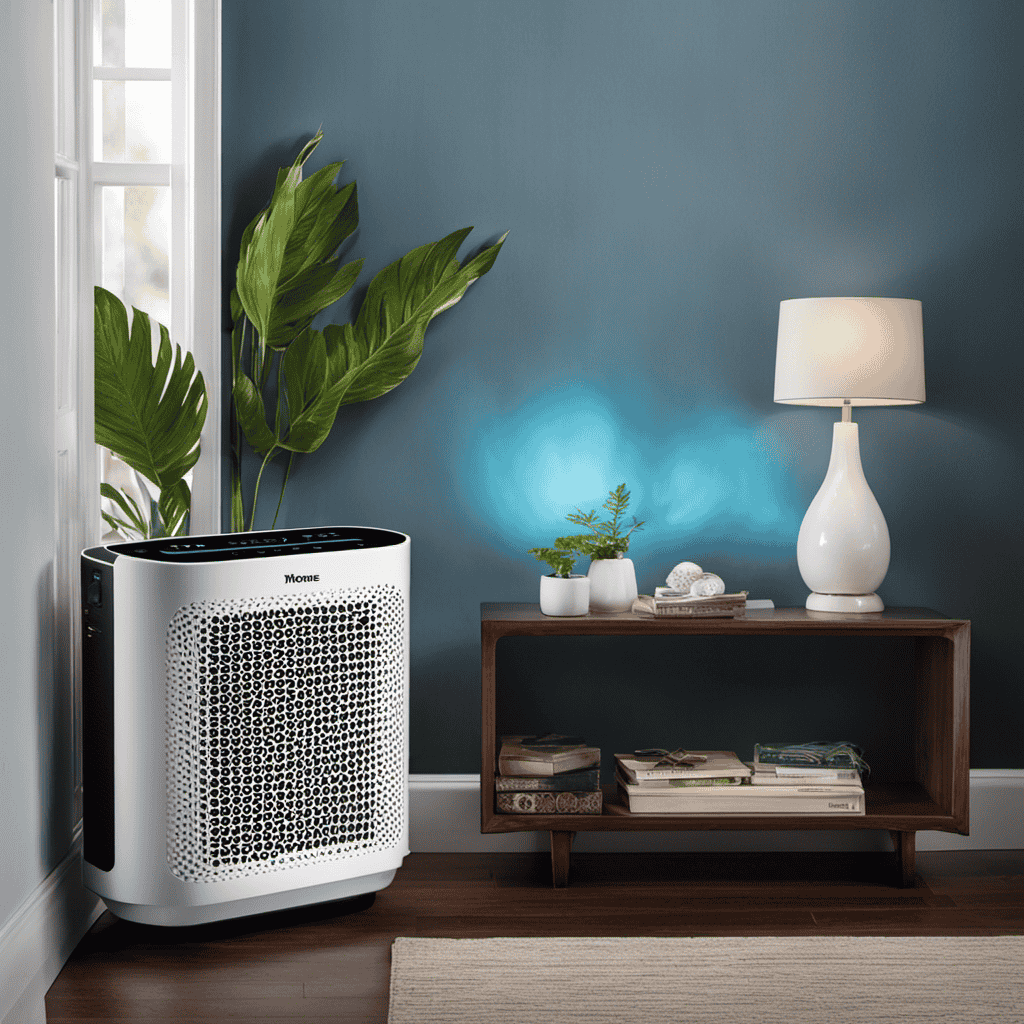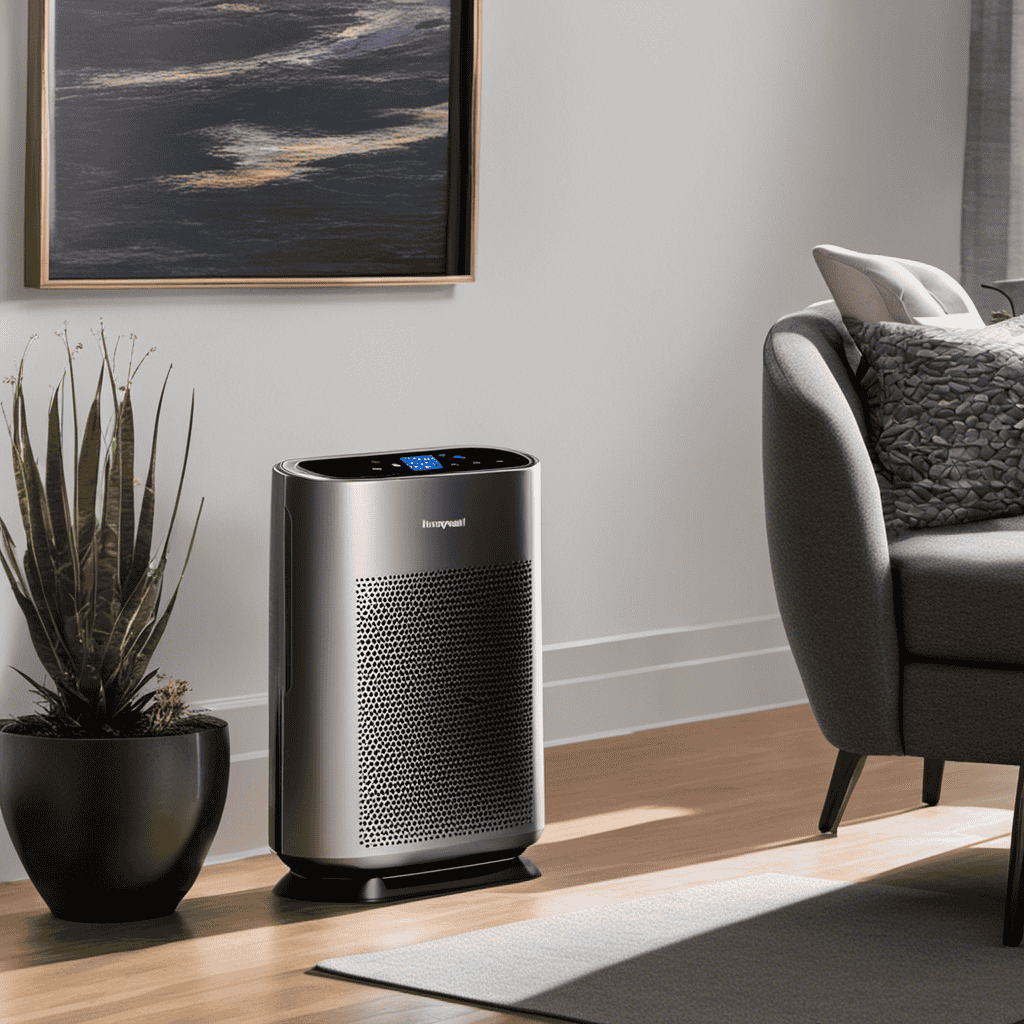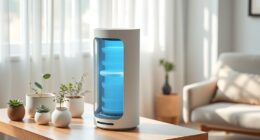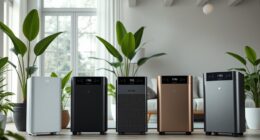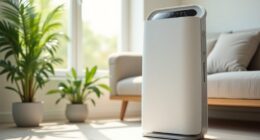When choosing an air purifier for smoke removal, focus on features that effectively tackle both wildfire and tobacco smoke. Look for True HEPA filters to capture tiny particles and activated carbon filters to absorb harmful chemicals and odors. Check the Clean Air Delivery Rate (CADR) to guarantee quick and efficient smoke removal. Consider the size of the purifier for your space, as some models can cover larger areas. Regular maintenance is key, too—replace filters as recommended. By understanding these essentials, you'll be better equipped to enhance your home's air quality and comfort during smoky seasons. There's more you might find helpful!
Key Takeaways
- Opt for air purifiers with True HEPA filters to capture 99.97% of smoke particles, ensuring effective smoke removal from the air.
- Look for models with activated carbon filters to adsorb odors and harmful VOCs from tobacco smoke, improving overall air quality.
- Choose air purifiers with high Clean Air Delivery Rate (CADR) ratings specifically for smoke to ensure efficient and quick purification.
- Consider the coverage area of the air purifier to match your space, ensuring optimal performance for smoke removal in larger rooms.
- Regular maintenance, such as replacing filters and cleaning pre-filters, is essential for maintaining the effectiveness of smoke removal capabilities.
Importance of Air Purifiers
Recognizing the significance of air purifiers in your home can greatly enhance your indoor air quality. These devices are essential for removing harmful smoke particles and pollutants that come from sources like wildfires and tobacco.
Smoke contains fine particulate matter (PM2.5) that can penetrate deep into your lungs, leading to aggravated respiratory conditions such as asthma and COPD. By utilizing features like multiple filtration stages, air purifiers can provide extensive protection against smoke and other airborne contaminants.
By using air purifiers equipped with HEPA filters, you can effectively capture 99.97% of particles as small as 0.3 microns, making them incredibly effective in filtering out smoke-related toxins. This is particularly vital in tightly constructed homes where fresh air exchange is limited, allowing smoke pollutants to accumulate to dangerous levels.
The health implications of smoke inhalation are serious; prolonged exposure contributes to approximately 1 in 5 deaths globally. Investing in an air purifier not only improves indoor air quality but also offers peace of mind, especially during wildfire season or in homes where tobacco is used.
Prioritizing air filtration can help protect you and your family from the adverse effects of airborne pollutants, ensuring a healthier living environment.
Key Air Purifier Features

When it comes to selecting an air purifier for smoke removal, understanding the key features can make all the difference in guaranteeing effective air quality improvement.
First and foremost, look for True HEPA Filters, which capture 99.97% of particles as small as 0.3 microns. This is vital for removing smoke particles from the air. Additionally, Activated Carbon Filters are fundamental for adsorbing odors and volatile organic compounds (VOCs) associated with tobacco smoke, enhancing your overall air quality.
Consider the importance of home cleaning services for maintaining an overall healthy environment, as clean air complements a clean living space.
Don't overlook the Clean Air Delivery Rate (CADR), as it indicates the efficiency of the purifier. A higher CADR rating guarantees quicker and more effective smoke removal.
Pre-filters are another important feature; they capture larger particles, extending the lifespan of your HEPA and carbon filters. Some pre-filters even come with antimicrobial treatment for added protection against particulate pollution.
Types of Smoke and Pollution
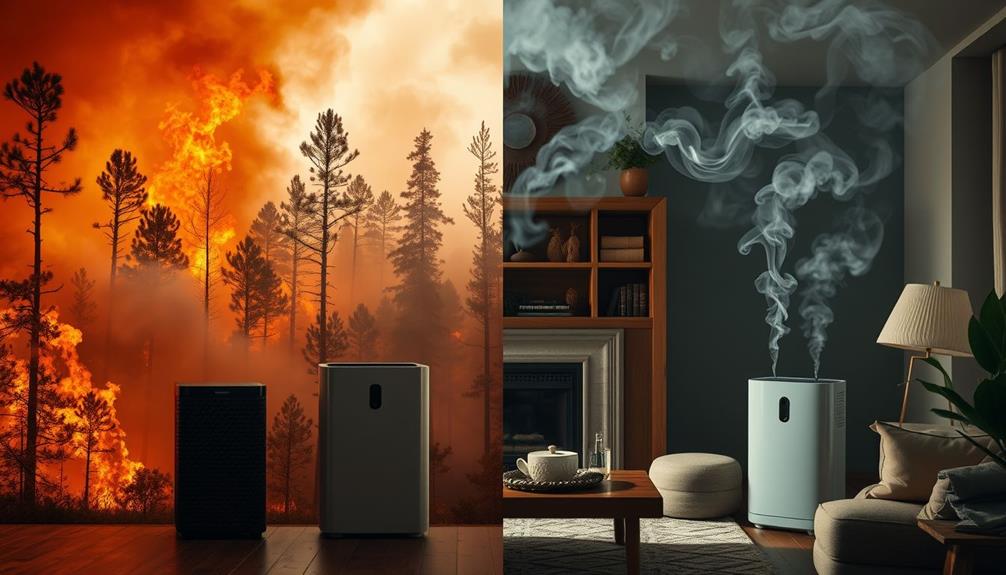
Understanding the types of smoke and pollution is essential for effectively addressing indoor air quality issues. Two significant sources of indoor air pollution are wildfire smoke and tobacco smoke. Each type brings its own set of harmful particles that can compromise your health.
1. Wildfire Smoke: This consists mainly of fine particulate matter (PM2.5) and volatile organic compounds (VOCs). It poses health risks, as 80-90% of its particulate matter is less than 2.5 microns, easily penetrating deep into your lungs.
Additionally, vital oils like eucalyptus and peppermint may provide some respiratory relief by opening airways and soothing sinus pressure, making them beneficial during wildfire season. essential oils for sinus congestion relief
2. Tobacco Smoke: Containing over 7,000 chemicals, tobacco smoke is notorious for its harmful effects. With about 40 known carcinogens, it's a potent indoor air pollutant that can lead to serious respiratory issues.
3. Air Pollution: Both types of smoke can travel long distances, affecting air quality far from their source. This means even if you're not near a wildfire or a smoker, you could still be impacted.
To combat these pollutants, effective air purifiers equipped with HEPA filters are vital. They can filter out smoke particles as small as 0.1 microns, improving your indoor air quality and protecting your health.
Best Air Purifiers for Smoke
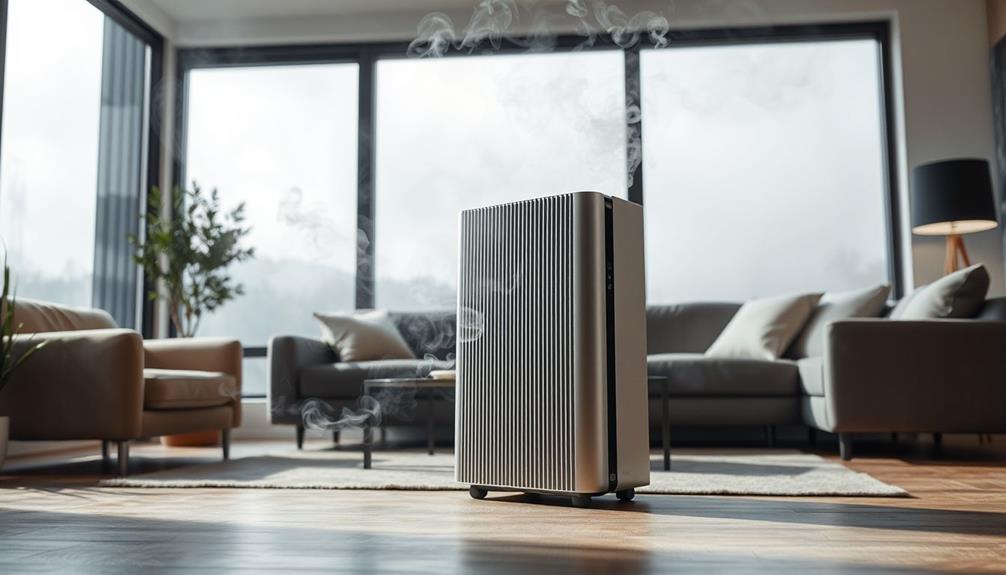
Finding the right air purifier for smoke can greatly improve your indoor air quality and overall health. When tackling smoke pollution, you'll want a device that efficiently captures large particles and PM2.5 particles. Here are some of the best air purifiers on the market:
| Air Purifier | Coverage Area |
|---|---|
| Blueair Blue Pure 311i+ Max | 465 sq ft |
| GermGuardian AirSafe + Intelligent | 1 hour cleaning |
| Rabbit Air MinusA2 | Space-saving |
| Coway Airmega 160 | 214 sq ft |
| Blueair Blue Pure 211i Max | 1,524 sq ft in 30 mins |
These models utilize HEPA filters and excel in air cleaning. The Coway Airmega 160, for instance, reduces PM2.5 and PM10 particles by 99.5% in just 30 minutes, making it perfect for smaller rooms. Meanwhile, the Blueair Blue Pure 211i Max is ideal for larger spaces, offering quiet operation and efficient purification. Keep in mind the coverage area and filter replacements when selecting your air purifier to guarantee peak purifier performance for your needs.
Maintenance and Care Tips
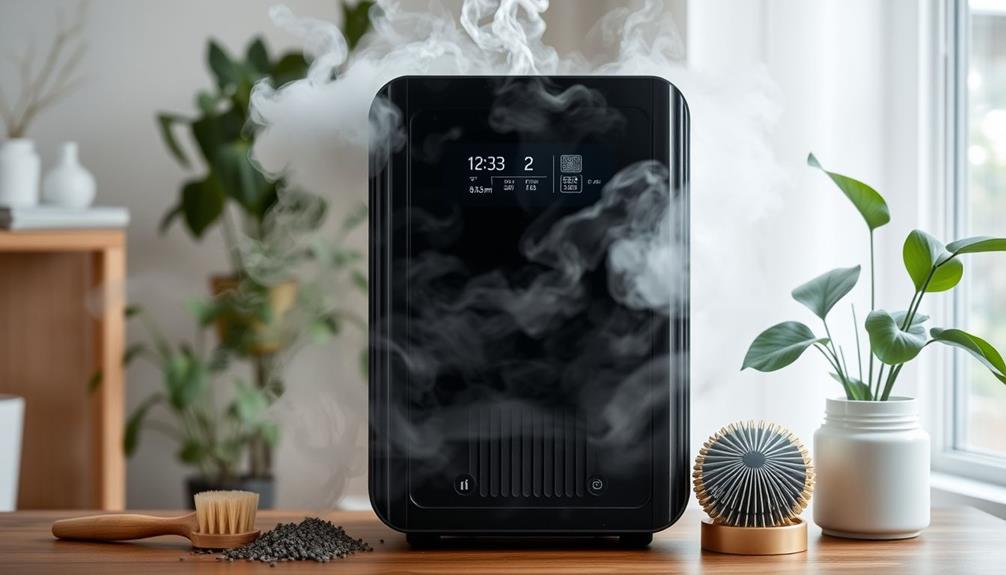
To keep your air purifier working effectively, regular maintenance is vital. Neglecting this can lead to diminished performance, especially when combating smoke exposure. For pet owners, maintaining a clean environment is essential, as dog health and nutrition can be affected by air quality.
Here are some key maintenance tips to follow:
- Replace filters regularly: HEPA filters should be replaced every 6 to 12 months to maintain peak air purification efficiency. For activated carbon filters, which are important for odor removal, aim to replace them every 1 to 3 months.
- Clean pre-filters: Periodically vacuum or wash your pre-filters (if washable) to extend the life of your main filters. This will help maintain airflow efficiency, guaranteeing your purifier operates smoothly.
- Monitor air quality indicators: If your air purifier has smart features, keep an eye on air quality indicators and filter replacement notifications. This will help you stay on top of maintenance and make sure your system runs at maximum performance.
Always follow the manufacturer's guidelines for maintenance and care, as different models may have specific requirements for peak operation and longevity.
Keeping up with these practices will help you enjoy cleaner air and a healthier environment.
Understanding Air Quality Standards
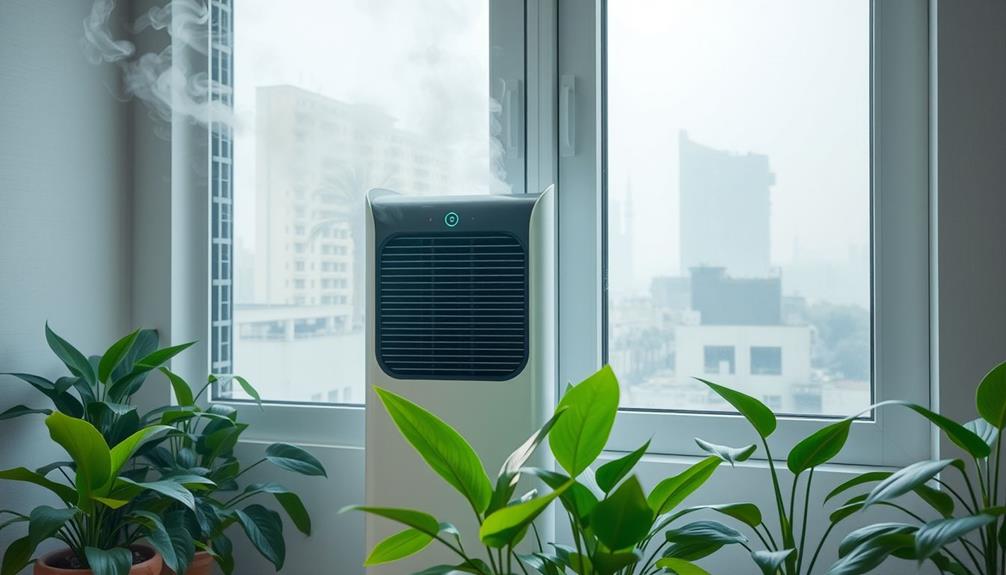
Air quality standards are essential for safeguarding your health, especially when dealing with smoke exposure. The Environmental Protection Agency (EPA) sets National Ambient Air Quality Standards (NAAQS) for common pollutants, including particulate matter (PM2.5). PM2.5 consists of tiny particles, 2.5 microns or smaller, that can penetrate your lungs and enter your bloodstream, leading to considerable health risks, particularly respiratory and cardiovascular issues.
Understanding the impact of geothermal energy on air quality can also inform your choices for cleaner energy solutions.
To protect public health, the EPA recommends PM2.5 levels shouldn't exceed an annual mean of 12 micrograms per cubic meter (µg/m³). The World Health Organization (WHO) suggests a stricter guideline of 10 µg/m³ to further minimize health risks from air pollution. During wildfire events, these levels can skyrocket, making the role of air purifiers essential for maintaining indoor air quality.
It's critical to choose air purifiers that meet or exceed Clean Air Delivery Rate (CADR) ratings for smoke removal. Effective filtration systems can considerably reduce PM2.5 levels in your home, helping you combat the adverse effects of smoke exposure.
Understanding these air quality standards empowers you to make informed decisions for a healthier living environment.
Making an Informed Purchase
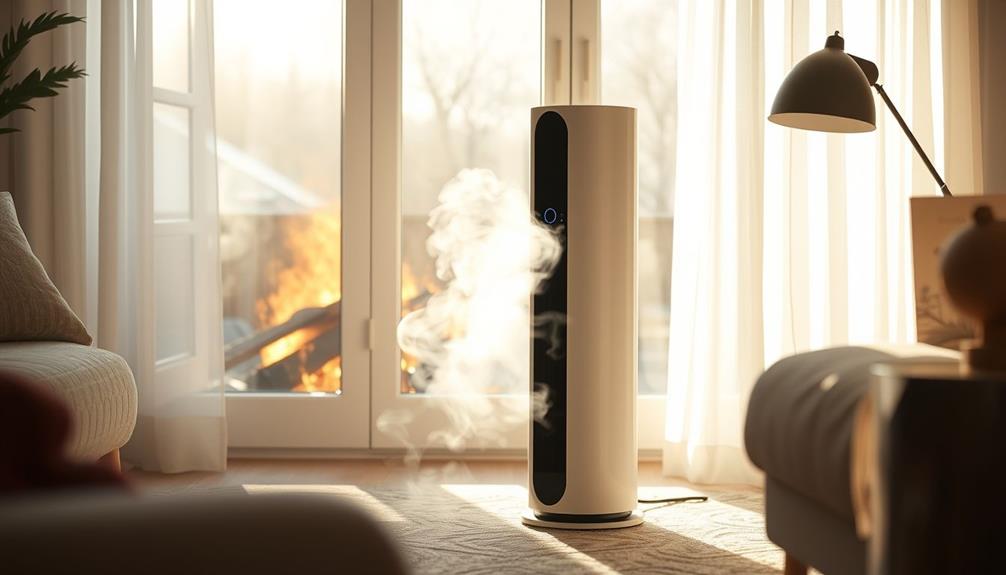
When you're ready to purchase an air purifier for smoke removal, it's crucial to focus on specific features that guarantee effective performance.
A solid understanding of home security systems can also help you create a safer environment while improving air quality.
Here are three key aspects to bear in mind:
1. True HEPA Filters: Look for models equipped with True HEPA filters, which capture 99.97% of particles as small as 0.3 microns, including harmful smoke and particulate matter. This guarantees superior smoke removal.
2. Clean Air Delivery Rate (CADR): Choose air purifiers with high CADR ratings specifically for smoke. A higher CADR means faster and more efficient purification, especially in larger rooms.
Make sure the purifier fits the room size—some models can handle areas up to 1,980 square feet.
3. Activated Carbon Filters: Opt for air purifiers that use activated carbon filters, as they effectively adsorb volatile organic compounds (VOCs) and odors associated with smoke, enhancing overall air quality.
Don't forget about maintenance; True HEPA filters typically need replacing every year, while activated carbon filters should be changed every 1-3 months.
Conclusion
Choosing the right air purifier can feel overwhelming, but it's essential for your health, especially during wildfires or if you're around tobacco smoke. By focusing on key features and understanding the types of smoke, you can make an informed decision. Coincidentally, just as you filter out harmful air, you can also filter out stress and anxiety, creating a healthier home environment. Remember, clean air isn't just a luxury; it's a necessity for a better quality of life.



